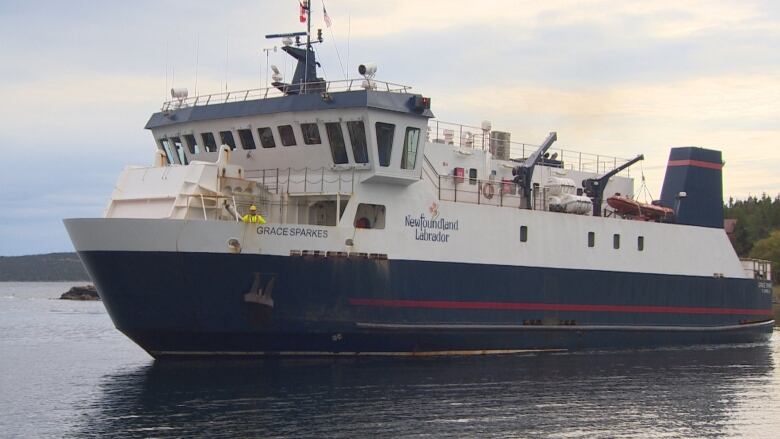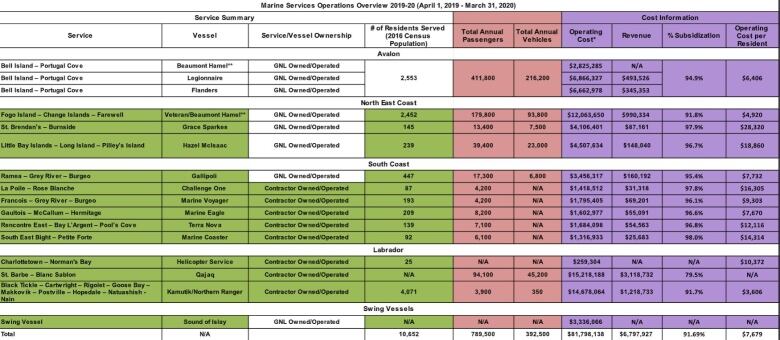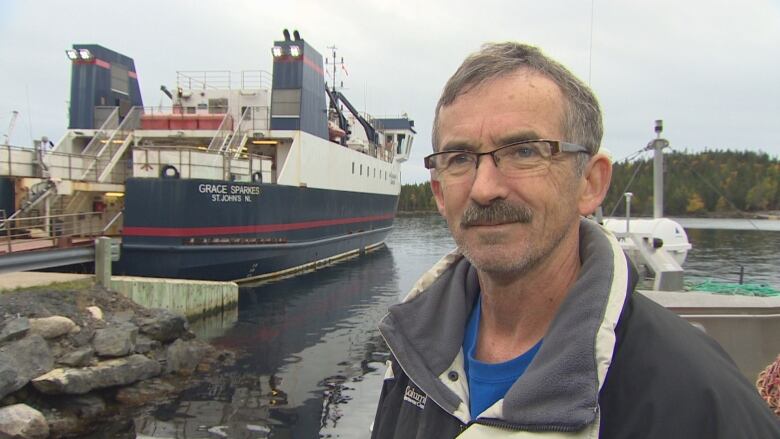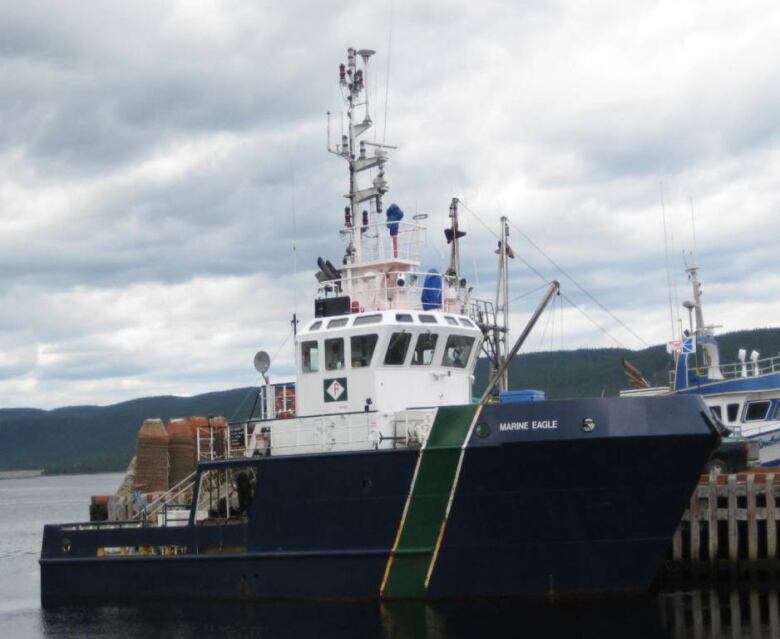Rough water ahead? Reduce ferry routes with few passengers, say most Vote Compass respondents
Leaders in community serviced by intraprovincial ferry service say they expect to be targets

There appears to be very little support for maintaining the current level of service for ferry routes with few passengers, according to data obtained throughVote Compass.
And such sentiment is not a surprise to leaders in communities served by the intraprovincial ferry system.
"It's always in back of my mind [because]it is an easy target. There'slots of dollars there," said Kevin O'Rielly, chairman of the transportation committee on St. Brendan's, a small island communityinBonavista Bay.
"I knows what it's going to be: cuts, cuts, cuts," added Gordon Hunt, mayor of Gaultois, a remote community on Newfoundland's south coast.
Ferries in the spotlight again
People taking part in Vote Compass on on cbc.ca were asked whether the provincial government should reduce ferry service for routes with few passengers.
Of the 4,096 respondents who participated in Vote Compass between Jan. 28 and Feb. 7, 69 per cent either somewhat agreed or strongly agreed that the ferry service should be reduced.
Eighteen per cent disagreed with the question.

With the provincial government facing a financial crisis, and a government-appointed team of experts doing a top-to-bottom review of public spending and services, people like O'Rielly and Gordon Hunt have a little more to think about these days when it comes to the future of their communities.
"As long as I've been here, I don't see we've ever been in a worst shape than we are," said O'Rielly. "And there ain't no way the few dollars they're going to save on us is going to fix our issue now."
"I feel sad about it; for this little town," said Hunt. "Most of the rest of the province is going to survive, but small towns around this area will be a thing of the past."

With Newfoundlanders and Labradorianspoised to elect a new provincial government on Feb. 13, there's even more of a spotlight on how scarce tax dollars are being spent, and where there might be opportunities to rein in what almost everyone agrees is a troubling pattern of overspending.
Moya Greene report
Moya Greene, the head ofthe premier's economic recovery team, was raised in St. John's, and rose to the top ranks of Canada Post and the British Royal Mail, witha reputation for privatization.
Sheis expected to deliver an interim report to the government at the end of the month, after voters go to the polls. A final report is scheduled for the end of April, and there's widespread expectation that some tough decisions are going to be recommended.

The so-called Greene Report is just one element in a strategy to try to deal with a net debt that now exceeds $16 billion, an ill-advised Muskrat Falls hydroelectric project that could double electricity rates by the time it is finished later this year, and a structural annual deficit that is nearing $1 billion.
Compounding the situation is a rapidly aging population that is putting additional strain on an already overtaxed health system, and a steady migration of young people to other provinces, includingNova Scotia, Ontario and Alberta.
Politicians of all stripes on the campaign trail have been signalling that help from the federal government is neededto avoid insolvency, and some suggest the province is already going under, with Ottawa having to backstop the province's ability to borrow last year in order to meet payroll.
The federal government also took measures late last year to allow the province to avoid making $884 million in payments for Muskrat Falls, while negotiations continue on a new financing arrangement for the project.
But while politicians hope Ottawa will again come to the rescue, there's also plenty of talk about spending reductions.

Health, education and other social programs represent the vast majority of spending, but with the ferry service subsidized by nearly 92 per cent, even those who depend on the service expect changes.
"We got to take what comes, I guess," said Hunt, who has been mayor of Gaultois for 12 years.
But if there are cuts, Hunt wonders what the service will look like.
"Right now there is no way they can cut our service any more than it is cut," he said. "She's down now to the minimum. If she's cut any more I wouldn't know what to do."
Thousands of empty sailings
The intraprovincial system includes eight government-owned and operated vessels, and seven that are privately owned contracted vessels.
Each year, the service transports nearly 800,000 passengers, almost 400,000 vehiclesand 13,000 tonnes of freight.
Last year, marine service operations cost the provincial government just under $82 million.
More than 10 per cent 4,100 trips of the nearly 38,000 runs made by theferry service in 2019-20were made without any passengers.
With many people staying close to home because of the pandemic, those figures are expected to increase during the current fiscal year.
Last spring, Transportation Minister Steve Crocker said communities served by routes with low passenger numbers should expect cuts.
Like many rural and isolated communities, the populations in Gaultois and St. Brendan's have shrunk significantly over the years.
Both the cost to transport people and cargo to the isolated communities is anything but small change.
'It's hard to make the economics makes sense'
According to the latest government data, the St. Brendan's-Burnside ferry service cost $4.1 million to operate in 2019-20, while it generated less than $90,000 in revenue from users.
The government estimates that the cost-per-resident for the service was$28,000, making it, by far, the most expensive ferry service in the province. But that's based on 2016 census data that put the population of St. Brendan's at 145. The population is now closer to 100, said O'Rielly.
"It's hard to make the economics make sense," said O'Rielly, a retired teacher who describes St. Brendan's as "a little piece of paradise."

The St. Brendan's route is served by the MV Grace Sparkes, a government-owned vessel purchased at a cost of $30 million nearly a decade ago.
O'Riellyis not surprised there issticker shock associated with the cost of the service.
"Listen, you could put a cheaper ferry service here. You got a boat there that's got 10 crew members; and they're on two weeks so that means there's 10 off at the same time. So yes you can put a ferry service here cheaper than that," he said.
In Hermitage Bay, the Gaultois-McCallum-Hermitage ferry service cost $1.6 million to operate last year, with just over $55,000 in revenue.
Hunt said he's not consumed by the ongoing debate over government spending, but is saddened by what it might mean for the future of his once-thriving community.
"The end will come one day. When? I don't know," he said.
Corrections
- A prior version of this story said that 79 per cent of Vote Compass respondents agreed that the ferry service should be reduced.In fact, it is 69 per cent.Feb 09, 2021 8:40 AM NT












_(720p).jpg)


 OFFICIAL HD MUSIC VIDEO.jpg)
.jpg)



























































































